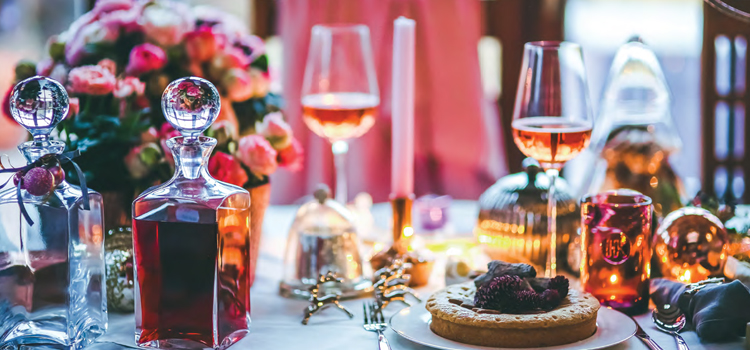Living
ONE DRINK TO RULE ALL

Two of India’s best sommeliers talk to us about wines and all attendant things.
Words by Rheanna Mathews Photographs from Various Sources
An elixir that has bewitched mankind for millennia, wine is available in many varieties today. Unless you belong to the wine cognoscenti, you may need help deciding what wine to pair with your food. This is where sommeliers come in – individuals with certified knowledge of wine (and other beverages), their present-day versions said to have evolved from butlers serving in wealthy households. FWD Life spoke to two of India’s star sommeliers who lead, according to one of them, “semi-charmed lives filled with lots of wines and great food”.
Magandeep Singh, certified at L’Université du Vin de Suze-LaRousse in the Rhone Valley, the first French-qualified sommelier in India, is also a writer and a TV show host. Gagan Sharma graduated from the University of Victoria in Melbourne, majoring in Hotel Management and specialising in wines. He has been certified by the Court of Master Sommeliers and is also a certified mixologist. They gave their opinions on the best wines of the year, the hopes pinned on India’s own burgeoning wine industry, and also advice for budding wine-lovers.
Star sommeliers
While being a francophile is what drew Magan into the glamorous world of French wines and gastronomy, Gagan knew there was no turning back when he experienced for the first time, in class, the alluring complexities contained in a single glass of wine. Most of us think about the wine industry as the domain of the glitterati. This also means that there might be widespread misconceptions about sommeliers in particular. Apparently, people tend to assume that sommeliers are old and bearded (and boring). Not so, asserts Magan (sommelier and tattooed triathlete). Gagan also clarifies that a sommelier is more than just a glorified wine-taster. According to him, a sommelier juggles various aspects of the restaurant, front of the house and at the back, constantly learning and exploring, to enhance the experience of guests.
Wines to look out for
Sommeliers contrive to keep an open mind and not judge wines by label alone. Speaking of their favourites of the year, Drappier and Taittinger were suggested and Indian wines like KRSMA, York Vineyard’s Arros Shiraz Cabernet and the 2013 Charosa Cabernet Sauvignon were top choices. Gagan was more vociferous about the quality of Indian wines, no doubt aware of the prejudice we Indians have against luxury items made in India. He remains keen to see how new varietals develop here, some of which will show in 2017. Commercial Indian wines have not long been around (merely two decades) but, Gagan says, they are worthy of being placed with international stars. The fact that India offers such quality produce, despite being on a latitude that does not contain natural grape-growing habitats, is an achievement in itself.
Nature and chemistry
Referring to talk of an Australian wine company looking to develop vineyards in Wayanad, Magan explained that the terroir or “a sense of place” would be significant. Grapes used for wine grow best in cool climates and if one has to tweak the wines from a particular region too much, then they taste nothing of the soil and climate where they were grown. The wine then becomes a product less of nature and more of chemistry, which is not desirable.
Pairings we’ll love
When it comes to food and wine pairings, easy options and more famous ones are Sauternes and blue cheese, oysters and Chablis and (one of Gagan’s personal favourites) cookie and cream flavoured ice cream with Vin Santo, a sweet dessert wine. Cheese with wine is vastly overrated according to Magan. Pairings are subjective and dependent on personal preferences, so trust your instincts. Usually, local wines complement local cuisines best.
What to keep
Local or not, wines are a staple during Christmas, and given how in Kerala there is a limit on the amount of alcohol an individual can possess, Gagan and Magan listed out some of their favourite wines and made a few suggestions keeping our hot, muggy weather in mind. Gagan spoke about how he holds a special regard for Barolos (Italian red wine), Ribera del Duero (Spanish red wine) and likes collecting wines that are a tad different, like Nebbiolo based sparkling and a bottle-fermented Prosecco. Magan denounced prohibition as a stupid idea, saying, “alcohol has been a part of human lives for millennia.
The industry should be regulated and the quality controlled; make it a clean industry rather than a shady business. Prohibition will only make the mafia stronger.” To do justice to the wines you collect, you need store them in a good, not necessarily expensive, cellar. Build for variety and build with balance, which means, have wines to store long-term but also to drink immediately. For budding oenophiles, start with wines that fit your budget, but try to invest in good wine glasses, as they’re an important tool that helps you really appreciate your wine.
Alluding to the tendency of some to hoard their wines, Magan says that he treasures a wine most after it has been opened. Open a bottle alone, and no matter how expensive it is and how rave its reviews, it might not be special at all. Almost always, it is the company you keep that truly makes the wine a treasure.
Magan’s Picks for Kerala
White Wines
- Grüner Veltliner from Austria
- Rieslings from Germany
- Prosecco from Italy
- Viogniers from France
Red Wines
- Pinot Noirs from Australia
- Blaufränkisch from Austria
- Gamay from France
- Bardolino from Italy
Gagan’s Swadeshi Choices
Grover Zampa Sparkling Wines
- Grover Zampa Chene (reserve reds)
- York Vineyards Chenin Blanc
- KRSMA Estates Cabernet Sauvignon
- Charosa Tempranillo
- Fratelli Vineyards Vitae Sangiovese
- Fratelli Vineyards Rosé
- Vallonne Vineyards’ sweet wines
Art
Navratri 2024: Celebrating the Nine Colours and Their Significance

Navratri, the festival that spans nine nights, is one of the most auspicious and widely celebrated festivals in India. Dedicated to the worship of Goddess Durga in her nine forms, each day of Navratri holds special significance, marked by a distinct color that carries deep spiritual and cultural meaning. As we prepare for Navratri 2024, let’s explore the nine colors associated with each day, their significance, and how they inspire devotion, positivity, and harmony.
Day 1: Yellow

On Thursday, embrace the uplifting energy of yellow as you celebrate Navratri with optimism and joy. This warm and cheerful color symbolizes happiness and radiates positivity, keeping you in high spirits throughout the day.
Day 2: Green

On Friday, wear green, a color that represents nature, growth, and harmony. It evokes a sense of peace and serenity, while also symbolizing new beginnings. Let the vibrant energy of green invite tranquility and the blessings of the Goddess into your life.
Day 3: Grey

Saturday calls for the subtle sophistication of grey. This balanced color keeps you grounded and calm, symbolizing composure and understated elegance. It’s perfect for those who want to participate in Navratri with grace while making a refined style statement.
Day 4: Orange

On Sunday, adorn yourself in the vibrant hue of orange. This color embodies warmth, exuberance, and positivity. Wearing orange during Navratri invokes an upbeat energy, bringing vitality and a lively spirit to your celebrations.
Day 5: White

Start your Monday with the purity and serenity of white. Associated with innocence and spiritual clarity, this color invites inner peace and helps you connect with the divine blessings of the Goddess, offering a sense of security and calm.
Day 6: Red

On Tuesday, red takes center stage, symbolizing passion, love, and strength. As one of the most auspicious colors, red is often offered to the Goddess in the form of a Chunri. Wearing red fills you with energy, vigor, and the vibrant spirit of Navratri.
Day 7: Royal Blue

Wednesday’s color is royal blue, representing elegance, richness, and tranquility. This deep, vivid shade of blue exudes confidence and sophistication, making it an ideal choice for those who want to celebrate Navratri with style and grace.
Day 8: Pink

On Thursday, don the charming hue of pink, a symbol of universal love, affection, and harmony. Pink is a color that adds a soft touch of warmth and approachability, making it perfect for creating a loving and joyful atmosphere during the festivities.
Day 9: Purple

On the final day of Navratri, purple takes the spotlight. Associated with luxury, nobility, and grandeur, purple invites opulence into your life. Wearing this regal color while worshipping Navdurga bestows blessings of prosperity and richness, making it the perfect way to end your Navratri celebrations.
Luxury
Cartier’s New High Jewellery Collection is a Love For The Wild

In 2021, the American Museum of Natural History in New York presented Beautiful Creatures, an exhibition showcasing some of the most eccentric jewellery designs of the past century. One standout piece was the iconic crocodile necklace of Mexican actress María Félix, a loyal Cartier patron. Félix, renowned for her bold sense of style, famously strolled into Cartier’s Paris store in 1975 with her pet crocodile, requesting a necklace in its likeness. Cartier delivered, crafting two intertwined crocodiles encrusted with over a thousand emeralds and yellow diamonds. For Félix, crocodiles symbolized freedom, an embodiment of the spirit she associated with Mexico’s Golden Age of cinema.

Fast forward to today, and Félix’s wildest dreams seem to have come to life at Cartier’s latest high jewellery collection, Nature Sauvage, previewed at the historic Kursalon Hübner gallery in Vienna. Among the star pieces is the Koaga necklace, a masterful creation where a zebra clasps an emerald-cut diamond and a 6.25-carat pear-shaped rubellite in its mouth. The zebra’s form is exquisitely rendered in alternating onyx stripes and pavé diamonds, making the creature feel almost lifelike.
The relationship between animals and jewellery has deep mythological roots, often glorified through rituals and symbolism. In ancient Egypt, scarab beetles were worn as earrings to signify respect for life’s cyclical nature. Meanwhile, in Hellenistic Greece, gods and goddesses took on the forms of winged creatures in adornment. So, what is it about animal-themed jewellery that continues to captivate us? According to Amanda Triossi, a jewellery historian based in Rome, the allure lies in our primal instincts: “Wearing wild animals like panthers or tigers gives one the sense of having conquered them. It’s empowering, as if you inherit the animal’s strength and attributes.”

Cartier captures this essence beautifully in its Amphista necklace. Featuring two intertwined snakes with diamond scales set with emeralds, their heads adorned with kite-shaped diamonds, the necklace echoes ancient Chinese philosophy’s yin-yang balance. The pièce de résistance? Nine octagonal Colombian emeralds, weighing a total of 14.72 carats.
Triossi also notes that many historical heroes are often depicted draped in the skins of animals they’ve vanquished, a symbol of triumph. Today, jewellery transforms that symbol into something precious and eternal—animal skins reimagined in imperishable materials.

Later that evening, at a celebration held at Vienna’s Kunsthistorisches Museum, the largest in Austria, the enchantment of Cartier’s collection was heightened. The museum’s octagonal domes featured paintings of animals dancing with angels, setting the stage for a magical night. Guests were greeted by masterpieces such as Rembrandt’s Self-Portrait and Caravaggio’s Madonna of the Rosary, alongside Cartier page boys in their signature red hats. The evening’s soundtrack, a seamless blend of Bach and Kygo, was curated by DJ Gillian Sagansky, lending a modern twist to the classical ambiance.
The following day brought another cultural adventure—a visit to Otto Wagner’s Villa, a stunning summer palace designed by the famed architect. The paintings adorning the villa’s walls depicted animals in various forms—some caught in purgatory, others wandering the biblical bardo, with alligators restlessly emerging from swampy landscapes.
Luxury
Indian Craftsmanship Meets Italian Savoir Faire : Rahul Mishra x Tod’s

Quiet luxury was expected to dominate for a while, with many predicting that the return of bold, extravagant fashion would take its time. However, maximalism seems to be making a swift comeback, especially in the realm of designer collaborations. Hot on the heels of the vibrant, print-heavy H&M x Anamika Khanna collection, another limited-edition line has arrived, celebrating opulent luxury: Rahul Mishra x Tod’s.
As part of Tod’s T-Factory project, which features exclusive collaborations with creative innovators, this marks Indian couturier Rahul Mishra’s debut in the international accessories space.

Mishra is a true ambassador of Indian design. Along with his wife Divya Mishra, he leads his eponymous label, which has brought the essence of India to the global stage in remarkable ways. A regular at Paris Fashion Week and the first Indian designer to showcase at Paris Haute Couture Week, his creations have adorned celebrities like Zendaya and Mark Zuckerberg, and have graced magazine covers in South Korea, China, and Europe. With such a path-defining legacy, it’s no surprise that Mishra and his visionary label were Tod’s natural choice for their first-ever Indian collaboration.
Mishra describes this collaboration as a beautiful fusion of “Italian craftsmanship serving as the canvas for Indian vision.” Tod’s iconic Gommino loafers and mules, along with the Di Bag and T Timeless shoulder bag, have been reimagined with intricate resham embroidery, crystals, and sequins—all meticulously hand-embroidered at Mishra’s atelier in Noida. “It was a technically challenging process that took time to perfect. I can confidently say these are some of the finest bags and shoes you’ll ever witness, in terms of craftsmanship and longevity. Such pieces are forever,” Mishra proudly shares.

Crafted entirely between India and Italy, the limited-edition pieces from this collection are a true love letter to the artisanal heritage of both nations. “There’s a beauty in the teamwork here,” Mishra explains. “We received raw materials from Italy and worked on integrating our embroideries seamlessly into their leather. The pieces were then sent back to Tod’s, where they transformed them into stunning, three-dimensional products. In that sense, it’s been a genuine collaboration between Italy and India.”
Mishra firmly believes that the future of global design will be shaped by a global Indian aesthetic. “Just as French, Italian, British, and Japanese designs are now seen as universal,” he explains. This collaboration marks a significant step in advancing that narrative. “When you push the boundaries of ‘handmade in India’ to be respected at the pinnacle of luxury, everything else will naturally follow,” he emphasizes.
-

 Style11 months ago
Style11 months agoBridal Guide : Best Looks of Radhika Merchant Ambani
-

 Fashion1 year ago
Fashion1 year agoMost Discussed Ajrakh Saree of Alia Bhatt
-

 Entertainment1 year ago
Entertainment1 year agoBridal Bliss : All Bridal Looks of Swasika Vijay
-

 Movies1 year ago
Movies1 year agoA Nostalgic Journey Through Love &Cinema : Best Bollywood Romantic 90s Movies
-

 AD8 months ago
AD8 months agoPopular Curtain Fabrics to Consider for Your Home
-

 Events9 months ago
Events9 months agoBest of Fashion Looks : Diya Krishna Wedding
-

 Events9 months ago
Events9 months agoThe L’Oréal Paris Show at Paris Fashion Week 2024
-

 news9 months ago
news9 months agoLaapataa Ladies: Kiran Rao’s Social Satire Becomes India’s Official Entry for the 2025 Oscars







































